We reviewed: choosing a task management system for web-studios
As we already said in previous posts, before creating PTYSH we tried everything, we tested many project and task management systems in order to choose good ideas for our own development. Not just a colossal, but a titanic work was done, the result of which is a shame to forget so easily, especially since the choice of a project management system often baffles the most sophisticated managers. It is even more difficult to choose a system for web-studio. You ask: “So this, you created a bunch of accounts and tested all these systems for me?”

 Before diving into Longrid about systems, we briefly define what needs we considered. What is a web-studio? This is a company within which very fast work is going on simultaneously on several projects, each of which may be at a different stage. Thus, employees are forced to strictly prioritize tasks and remember the most insignificant details that cannot be taken into account when creating and managing sites.
Before diving into Longrid about systems, we briefly define what needs we considered. What is a web-studio? This is a company within which very fast work is going on simultaneously on several projects, each of which may be at a different stage. Thus, employees are forced to strictly prioritize tasks and remember the most insignificant details that cannot be taken into account when creating and managing sites.
Based on this, we will look for:
Of course, the environment of the task manager will also not be deprived of attention, but the emphasis will be placed on the listed parameters. And yes, all screenshots are clickable - you can take a closer look at them.
This section includes systems that are customarily used, for example, as a bug tracker or an incident and ticket management system, but which also deserve attention as task managers. I will make a reservation right away - most of them are too complicated and cumbersome for the business processes of the web-studio, but still are of interest.
Perhaps this is the most unusual system of all that I had to study. The magic of IT retro begins with the installation process itself, when you have to deploy the server manager on the desktop, manually create a clean database and then go to the web-based interface of the system, simultaneously looking at the state of the database. The interface that came to us from the mid-2000s is just as unusual. However, this does not deprive TrackStudiogood project management capabilities. If someone decides to understand, I strongly recommend arming with documentation: there is a lot of useful information for both users and developers. Personally, I was reassured by the title of the section “How to Control the World Using TrackStudio”. Actually, that's what I did. I must say right away that TrackStudio is not a story for web-studios at all, because it is simply not necessary for people like us. Such functionality and powerful refinement tools are more suitable for large companies that squeeze money for expensive systems or for development companies: in my opinion, TrackStudio can be sharpened both under the development management system, and under the bug tracker, and under the ticket and incident management system. Despite this statement, I will dwell on project management in more detail.
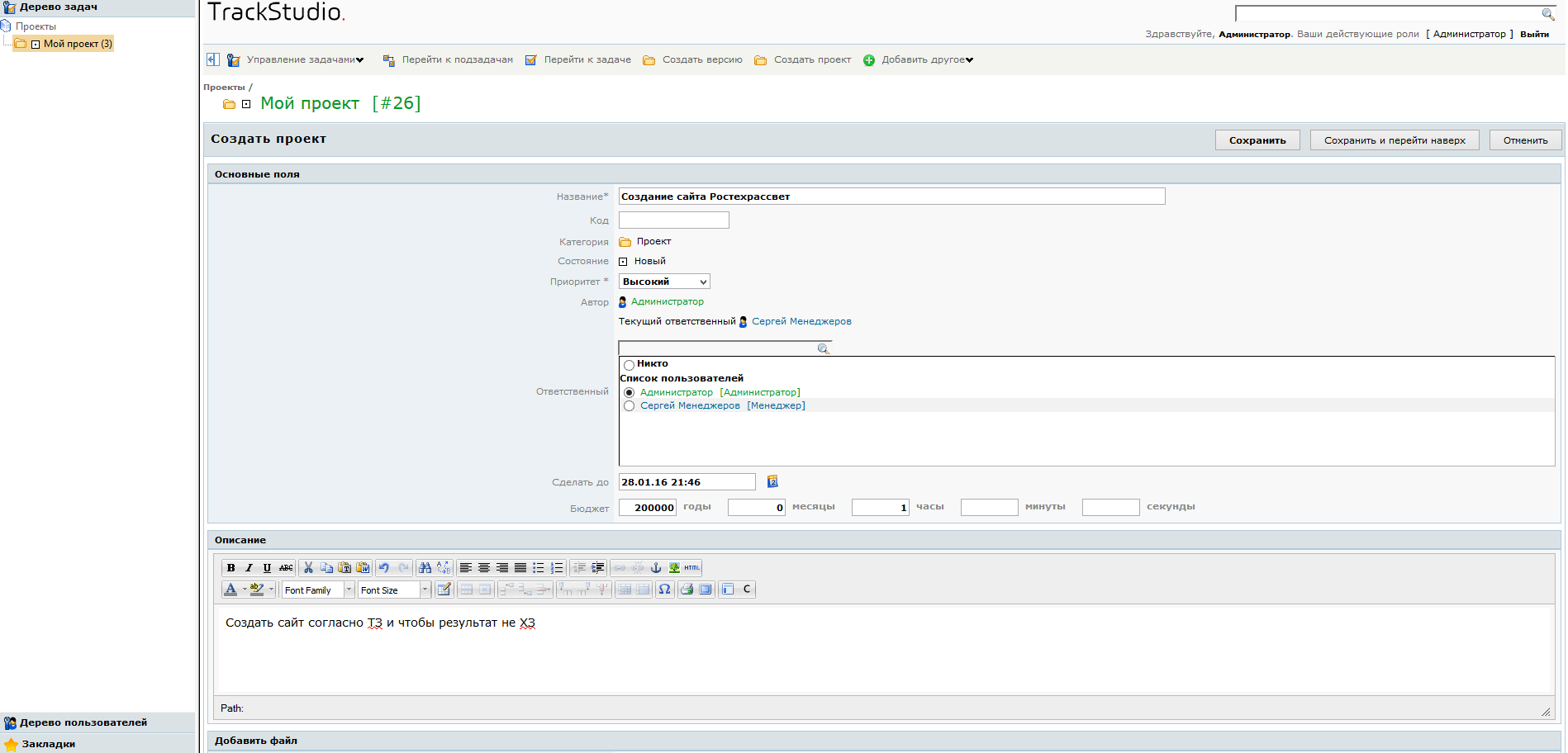

Tasks are collected on the desktop of the system and at the same time have a representation in the form of a tree. The main essence is a project in which you can create other projects and tasks. Using TrackStudio, you can create various categories of tasks (bugs, requirements, information, etc.), they will be displayed in conjunction with the project. A task category requires you to configure relationships between categories (where a task can be created) and allows you to configure triggers (then a user-created script can be executed when creating and editing tasks). For all projects, you can build reports in the form of a list, details, distribution report, time spent, task structure, trend, time sheet and Gantt chart. Some reports are downloaded in XML and in the MS Project format; this may be necessary for someone to upload to external systems.
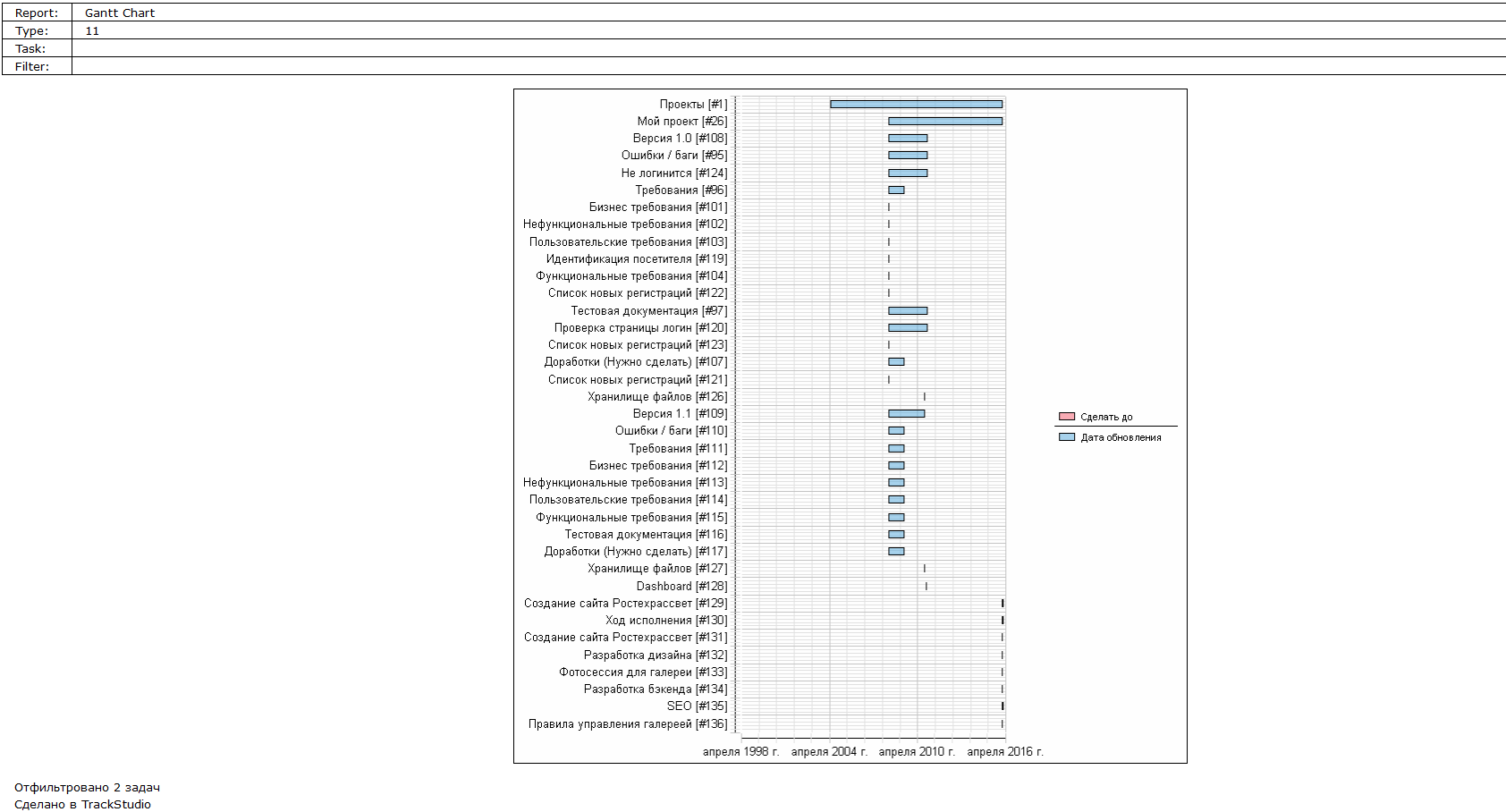
TrackStudio is a powerful and interesting solution for those who have programming skills and time for a long start. I am convinced that with a long setup and preparation, the system can take on any guise and reliably solve various problems, especially since it can be configured for any DBMS. However, for a modest (and not modest too) web-studio, the solution is too complicated, moreover, TrackStudio does not have a ready-made convenient mechanism for completing tasks, checklists, quick task management models (assignment, delegation, control, etc.).
On the net you can read thousands of laudatory reviews on Redmine . Moreover, they praise him both as a bug tracker and as a task manager, which means that we have no right to pass by. Frankly, I did not often have to work with the command line in Windows, but Redmine decided totake my soul to accustom me to it. I was surrounded by manuals and for a long night I learned how to install Ruby, DevKit directly from the command line, deploy MySQL DBMS and run Redmine as a service on Windows. But we are still talking about web-studios, why do they need so much trouble, is there really no ready-made installation package for people who are not burdened with knowledge of development or system administration? I found the answer in the comments to the post on Habré.
Bitnami deploys Redmine in minutes. So, if you are not a fan of the above operations, run Redmine in the browser and use it as a task management system. Redmine is very simple: minimalistic design, simple menu and a good set of clear settings. Before you start working in the task manager, you should go to the settings in the "Administration" section: there you can create custom sets of trackers, task categories, specify the sets of columns that will be displayed in the task lists. Such preparatory work will allow you to manage tasks initially in an orderly manner.
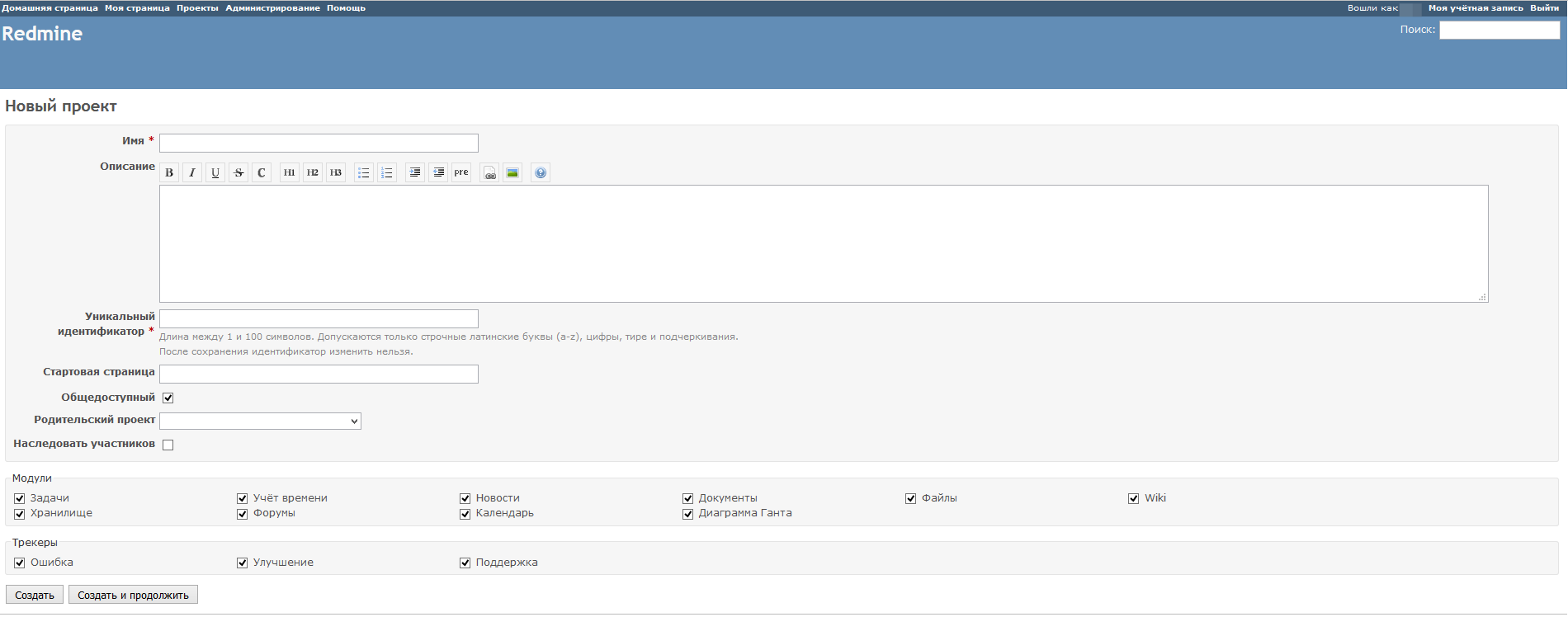
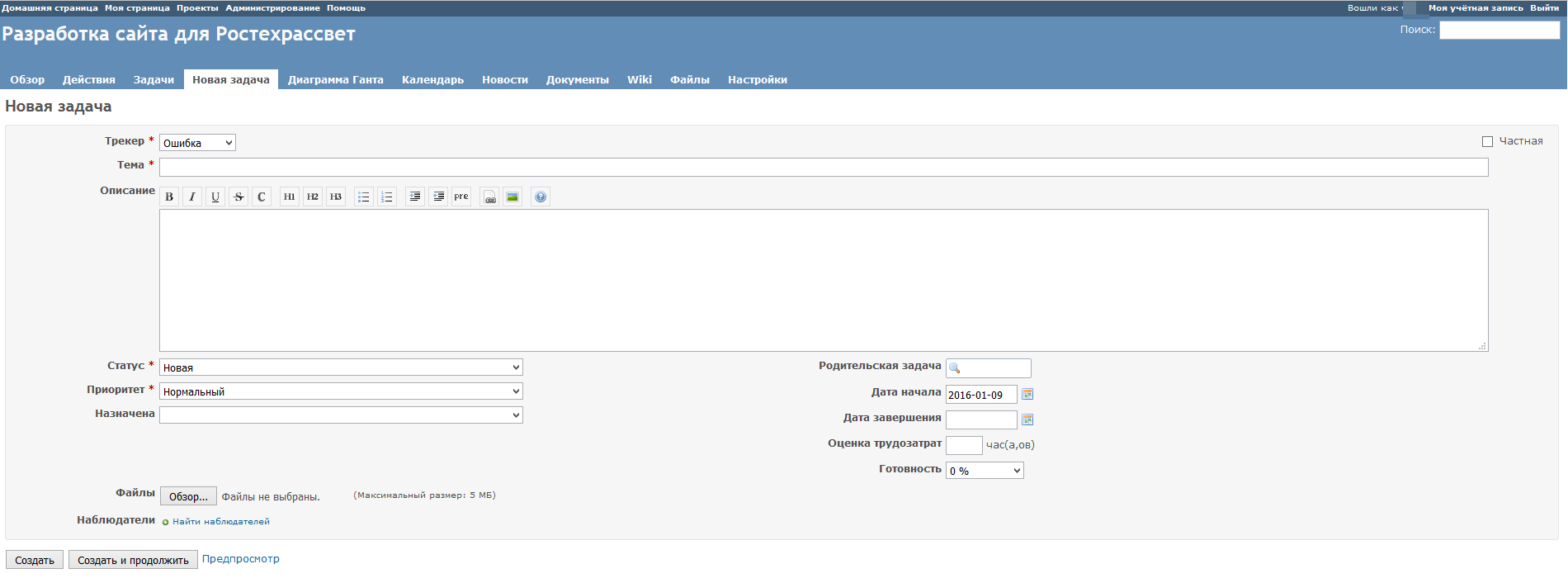
Tasks in the project are created simply: name, description field, degree of readiness, labor, deadline, status. You can only change the execution status (including close) by editing the task. Checklists are not provided. All tasks are displayed in a calendar and on a Gantt chart: when you hover over a section of a task, you can see its card, dragging and dropping elements with the mouse is not provided. In a separate window you can see the project documents, conduct a discussion on the forum, create and fill in useful information Wiki. In my opinion, Redmine is good precisely because of its many settings (and of course, free of charge). He is good both as a bug tracker and as a task manager, especially for companies in which tasks do not require detailed fragmentation, but are actively discussed and it is important to maintain the accumulated experience of the discussion.

Since we are talking about Redmine, we will focus on Jira - another system that is popular with developers. When launched, Jira prompts the user to select the necessary modules: developers - Scrum, Kanban, Basic software development; business - process management, project management, task management. The system interface is in English, in the basic delivery you can choose the Russian language of the institution of tasks. However, there is a Russian-language localization, it can be added to the system plug-ins and used by Jira in their native language. By the way, since we are talking about plugins, Jira offers many useful add-ons, among which there is something to choose.
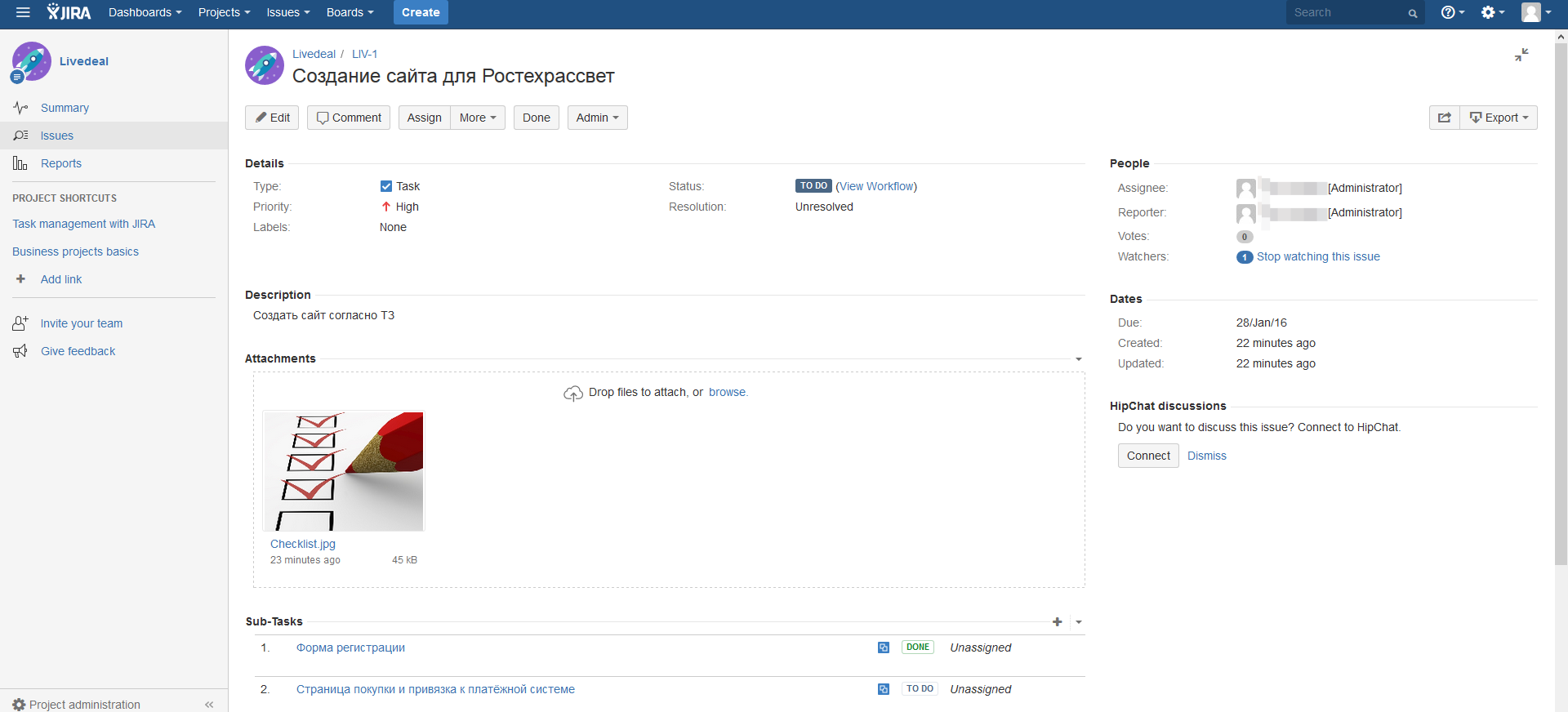
So, when creating Jira, we chose Project management, which means that the main essence of this section is the project. Tasks are registered inside the project using the form in which the fields for the deadline date, responsible, attachments, formatted description, followers, priority, tags and comments are defined. If necessary, unnecessary fields can be eliminated by saving the user set of fields of the institution. Inside the task, subtasks are created in the form of a list in which the status of execution is displayed. All tasks and subtasks are displayed in the left pane in a list, next to a description of the selected item. Completed tasks can be displayed in the general list by selecting the appropriate option. Based on the results of the work, you can build reports based on ready-made templates. Summary of activities and task structure are available in the Summary section.

In general, Jira is quite convenient for working with projects, work with freelancers can be moved to a separate section. If the company is more focused on development, then Jira will be an excellent choice: each unit will work in its own project and at the same time in a single functional system.
Actually, it's time for Jira to finish with perversions and consider systems more suitable for the tasks.
These systems, in turn, are divided into two parts: where project management is a module and where project and task management is almost the only goal of the program. Let me explain why it is sometimes advisable to buy CRM / ERP / xRM with a task management module. If the company starts as a small studio, but has plans to expand its service portfolio and omnichannel promotion, then it is worthwhile to look closely at complex solutions so that it is painfully not to integrate all the software necessary for work. Believe me, there is nothing wrong if your sales people initially start to lead customers to CRM - you will benefit from this by gaining a managed customer base. On the other hand, if you decide to develop in only one direction (for example, to be a web-studio and become the coolest in this direction), then you should limit yourself to a tool, most suitable for the main tasks. So…
amoCRM in the left toolbar offers the tab "Tasks", in which you can directly add tasks and manage them. It is also allowed to assign tasks from the transaction card and contact card. Initially, amoCRM provides two types of tasks: follow-up and meeting. This, of course, is not enough, so literally in a couple of clicks you can create many custom types of tasks: for example, calls, development, design and everything that your activity requires. The form for adding a task is rather meager: choosing the date and exact time, specifying the contact or transaction associated with the task (in fact, you can enter any data in the field), for whom the task (choosing from the list of employees in the system), task type and comment ( surprisingly, it is a required field until you complete it; the task cannot be saved). The ability to create milestones and subtasks was never found,

Tasks in amoCRM can be displayed in the form of a list, a one-day calendar with time divisions, a calendar for a month, as well as a to-do line on which tasks for today and tasks for tomorrow are visible. To close a task from the to-do line, drag it down with the mouse and then another line appears with segments: delete, the day after tomorrow, the next week, the next month, complete. Honestly, a very unobvious interface solution - only an understanding of standard interfaces helped me find it. I think the novice manager would freeze for a long time. In the list view of the task, it’s easier to close the task, for this it is enough to put a hint (tick) at the task name and the menu will open: open tasks, close tasks, delete. When you try to close the task, a window pops up asking you to specify the result. Closed tasks do not appear in the taskbar, but they can be found on the amoCRM desktop in Recent Events and in the corresponding deal. From the pleasant thing - displaying the number of tasks set, completed and expired on the amoCRM desktop dashboard. This dashboard, of course, is not the right thing, but beautiful. Since we are talking about CRM, it is possible to put down the amount of the transaction, track the stages of interaction with customers (funnel).
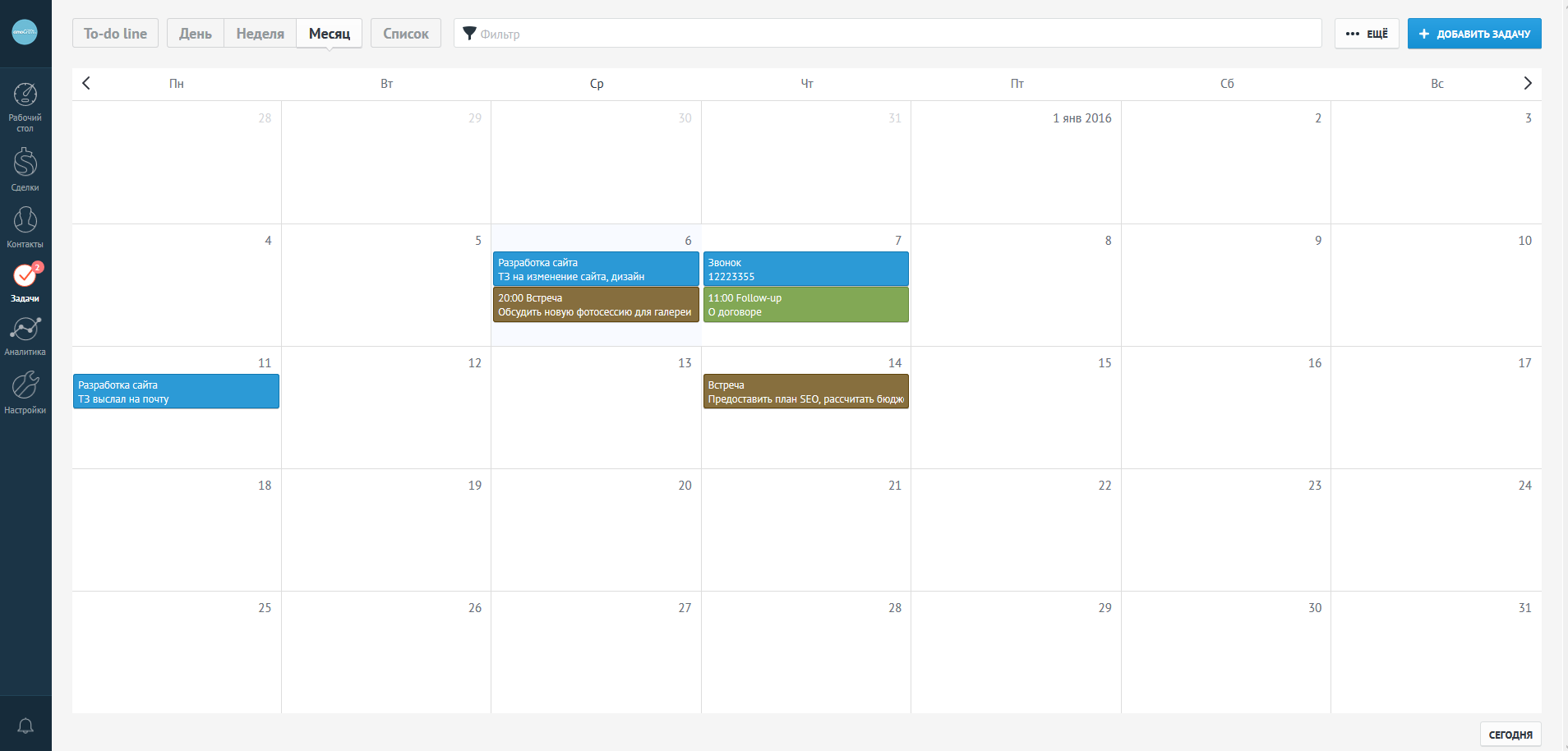
In general, amoCRM does not quite fit into the needs of web-studio task management. First of all, because this is CRM, aimed primarily at solving the problems of the sales department. The task management module itself does not have the functionality necessary for the studio.
Tasks actually underlie Bitrix24. When they are created, the name, initiator, co-executors, priority are established, the start and end dates for the task are planned. Inside the task, you can create a checklist with subtasks - this is very convenient for monitoring the stages of the work or the to-do list of the employee. The task can be attributed to the project, which can be created according to the criteria necessary for the user (department, work, direction, office, etc.). For a task, you can choose to followers or employees to whom it is delegated. Homogeneous tasks can be made cyclic or created in the future using saved templates. All tasks are divided by status and can be displayed both in tabular form and on the Gantt chart. In the case of Bitrix24, you can manage tasks directly on the chart rulers: by right-clicking, the task management menu opens, left - the task card opens. By the way, in Bitrix24 it is possible to create work groups for external users.

In terms of working with tasks, Bitrix24 will definitely not fail. However, the system itself is an entire corporate portal with a sales management module and CRM. For web-studio, the system is clearly overloaded. However, these words can be attributed to absolutely all CRM that we studied. In most systems, tasks and schedulers satisfy almost all requirements, but does the company need this? The point here is not even the cost of software, but the fact that each employee will have a lot of unnecessary functionality before their eyes that will only confuse and distract - it's just inconvenient to work. However, as I said, if you need advanced sales and customer management, KPI execution control and accounting, take a look at complex systems.
Megaplan initially positioned itself as a project management system. Gradually, for the sake of the market, he began to disguise himself as CRM, which, however, does not contradict the definition of a customer relationship management system. However, it is the project management and task setting module in Megaplan that has been implemented quite strongly, taking into account the smallest details. The first advantage is the hierarchy and nesting of tasks: tasks, subtasks, milestones, affairs, subprojects are created inside the project. Such a hierarchy allows you to organize work and actually build a project map; access to each element can be obtained by clicking on the link for the name of the task, subtask, etc.
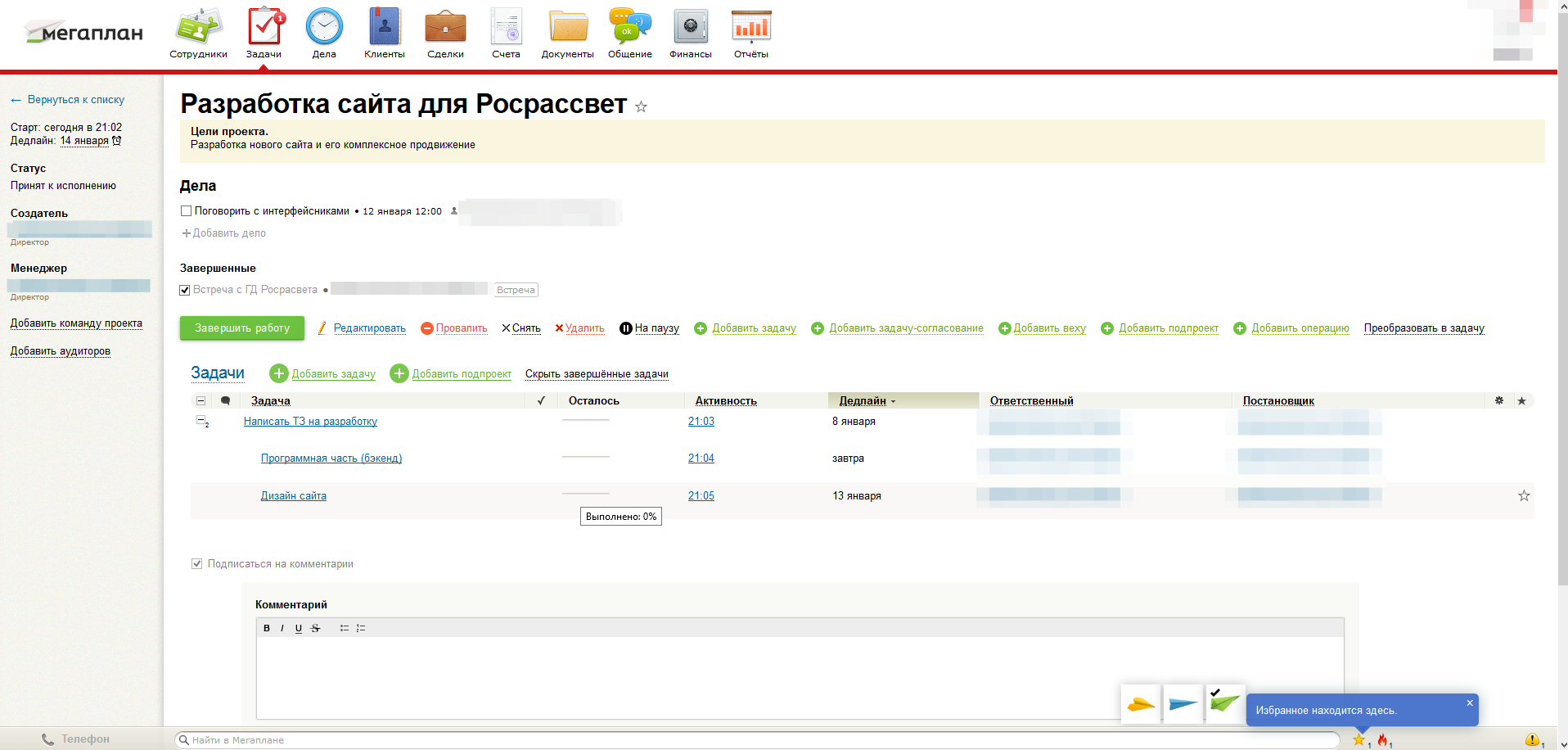
The task creation form provides for a large set of fields, of which the minimum is mandatory. Inside the task, a responsible, possible bonus for execution, deadline, access rights to the fields is set. In the additional fields you can set the duration, start date and finish of the task, set the planned labor costs. Among the participants in the task, you can optionally specify co-contractors, auditors, and customer. If necessary, you can configure the rules for repeating the task every day, week, month or year. Subtasks are created in similar forms. Tasks and subtasks can be completed, edited, removed, deleted, paused, delegated and even fail (in fact, completed without a result and work on the task). Failed and completed tasks are displayed in the list in gray, at the request of the user they can be hidden. In the Megaplan, tasks can be displayed both in the form of a list, hierarchy, and on a Gantt chart. However, the Gantt chart in Megaplan is quite nominal - you can see the tasks on it, but it is impossible to move and edit them directly on the chart.
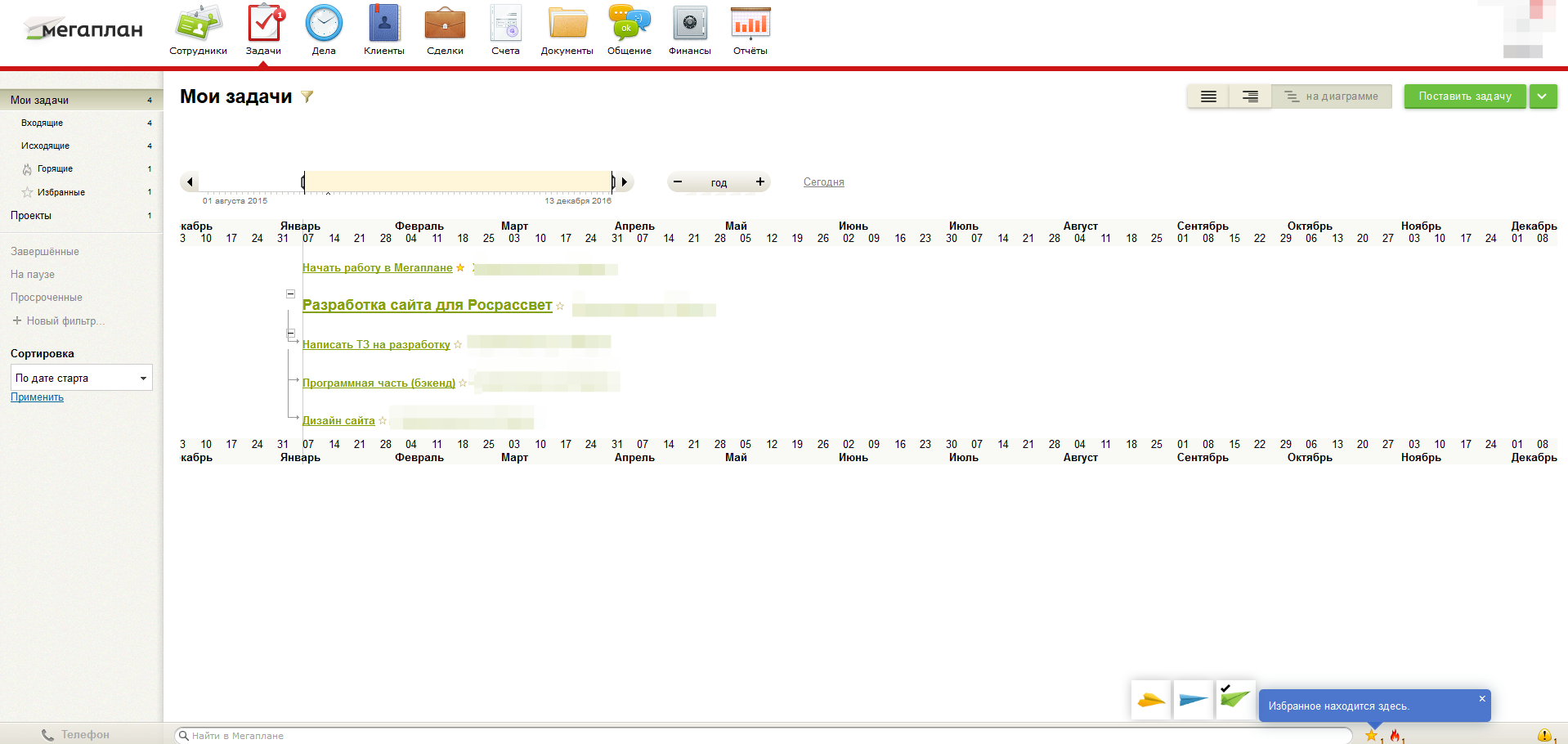
In general, Megaplan is suitable for almost any company that needs a project management system (except, perhaps, development and industrial companies that make specific requirements for the system). Of the minuses, I note a slightly overloaded interface and a Gantt chart, which, alas, has remained unchanged for three years now. Personally, again, I did not have the classic simple checklist with checkmarks and striking out completed tasks.
This included “profile” task managers, each of whom is able to automate and greatly facilitate team work, partially solving the problem of losing critical and missed deadlines. At a certain stage in the development of my company, I would probably choose each of the systems listed in this section.
Next I will review the Pyrus project management system . Pyrus itself positions itself as a system that is different from the project management system, document management and business processes. It is impossible not to note the possibility of integration with many services and the availability of APIs, but we agreed that we are interested in project management, so we turn to it.

The form for creating a task is simple: a large text box for entering the text of the task, linking the task to the project, responsible, deadline, control label, the ability to upload a file (Google Drive, Box, DropBox, OneDrive). Optionally, directly from the card, you can add the task to Google Calendar, assign several stages of coordination and determine the folder for the task. If not a single project was started before the task was created, the project can be created directly from the task card in a separate window - conveniently. You can also create custom templates for creating a business process (for example, routing and approval of documents), specify the budget of each stage. It is possible to create repetitive tasks, this is the necessary functionality for routine tasks, which there are always a lot of in web studios. All tasks are divided into folders: incoming, last, on the control. Inbox in turn, laid out in "long boxes": today, planned, next, someday. I do not know about you, but such a classification seemed mysterious and not clear enough to me.
Tasks can be reassigned, linked to another project and completed with different results. Like in several other systems, I didn’t have enough checklist, fields for adding brief notes for each participant in the process and didn’t like that tasks after completion are forcibly put into “All tasks” and are not displayed in other folders. In general, the system does not quite fit the tasks, although I am sure that those who need them will forgive everything for its integration capabilities.
iQ300- An affordable, understandable project management system that meets almost all the requirements that a small company can make to such systems. A cloud system with a concise interface and obvious entities makes it possible to create projects, tasks, checklists (finally!), Write comments, attach documents and log all user actions. The main essence is the project, within which tasks and subtasks are created. When creating a project, a fairly complete card is formed, taking into account goals, risks, success criteria, and result. Of the obviously pleasant things, it’s possible to create working groups (communities): for example, you can create Freelancers, Udalenka, and Branch in Cheboksary groups and separately monitor activity, speed of work with tasks, and overall progress. This is the functionality
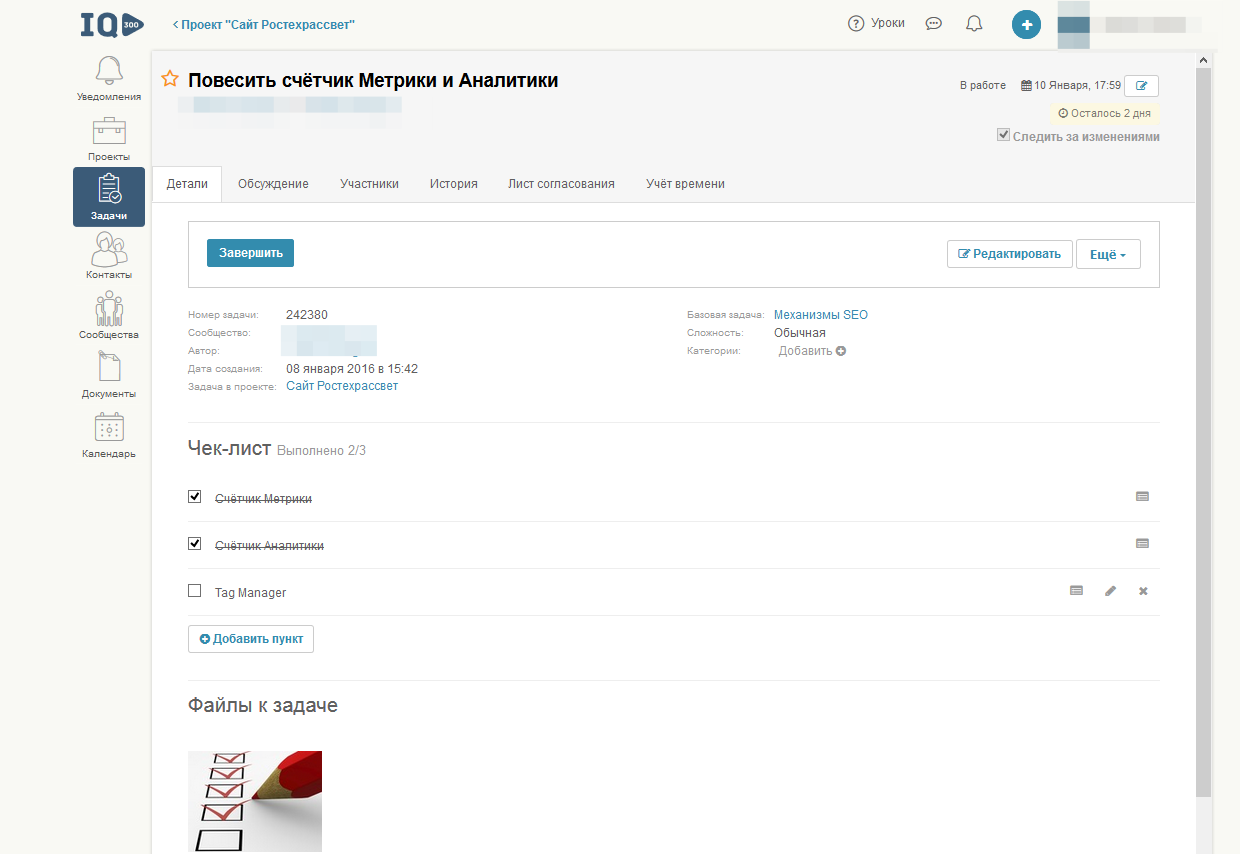
However, not everything is so simple - the first pleasant impression is erased somewhat in the process of creating tasks. Judge for yourself: initially a draft of the task and subtasks is created, then you must manually change the status of the task to "In Work". By the way, this can be done through the "Convert to task" menu: here you are involuntarily wondering what will happen if you use such a conversion for a subtask? Spoiler: nothing will happen, the subtask will become active. When creating a task, the field of the person responsible for the execution is not mandatory, however, if you want to activate the task and the executor is not there, you will not succeed and no hints will pop up - guess yourself as you work. However, after several clashes with restrictions, you begin to understand the logic of the system and it becomes quite friendly: check lists are easy to close, you can enable or disable the display of various types of tasks, including completed ones, control is carried out through a simple menu, group operations are possible. Within the project, you can discuss, there is a schedule (in essence - a basic Gantt chart with the ability to view the task when you hover over a segment and drag the rulers and time axes), in a separate tab there are documents and multimedia about the project, you can build reports on tasks, performers, the course of execution of orders, the time spent. Tasks, depending on the status, are highlighted in different colors - everything is very clear. there is a schedule (in essence - a basic Gantt chart with the ability to view the task when you hover over a segment and drag the rulers and time axes), in a separate tab there are documents and multimedia for the project, you can build reports on tasks, executors, and the execution of instructions, time spent. Tasks, depending on the status, are highlighted in different colors - everything is very clear. there is a schedule (in essence - a basic Gantt chart with the ability to view the task when you hover over a segment and drag the rulers and time axes), in a separate tab there are documents and multimedia for the project, you can build reports on tasks, executors, and the execution of instructions, time spent. Tasks, depending on the status, are highlighted in different colors - everything is very clear.
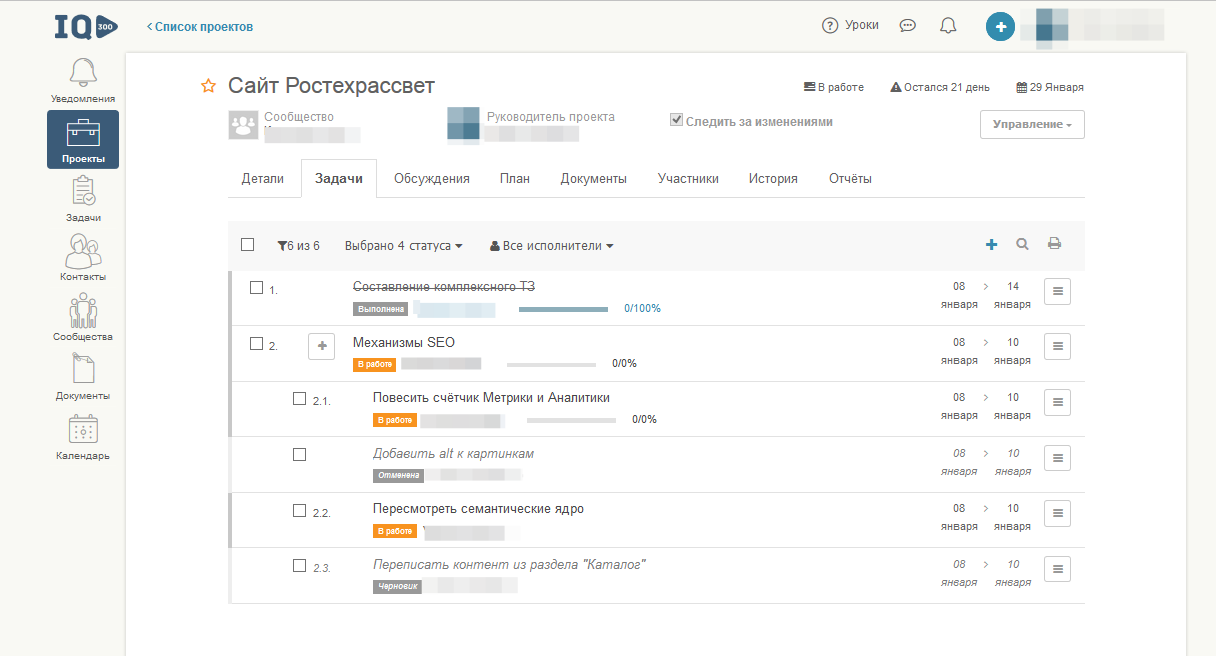
The system is extremely easy to learn, but despite this, it provides manual lessons with screenshots and good recommendations for managing tasks and projects. Of the shortcomings, I will highlight the sometimes illogical behavior of the interface and the inability to display checklists in the project field, access to them is possible only through the task. Using the iQ300 is a matter of habit, it took me less than an hour to form.
WorkFlow Soft is another system that I came across in the course of my global research. In principle, it is no different from many reminder systems: there are no check lists, task category labels, etc., tasks are created in the minimum standard form. But the system cannot exist without chips: in WorkFlow Soft it is a constructor of templates and task execution routes. Routes are constructed in an interface that is clear and pleasant to the eye, attached to the task and can be launched for execution - in fact, this is one of the options for modeling business processes. Obviously, the stake is made precisely on the logical coherence of tasks and the possibility of building chains of work: from coordinating a document to developing a site and releasing a new product.

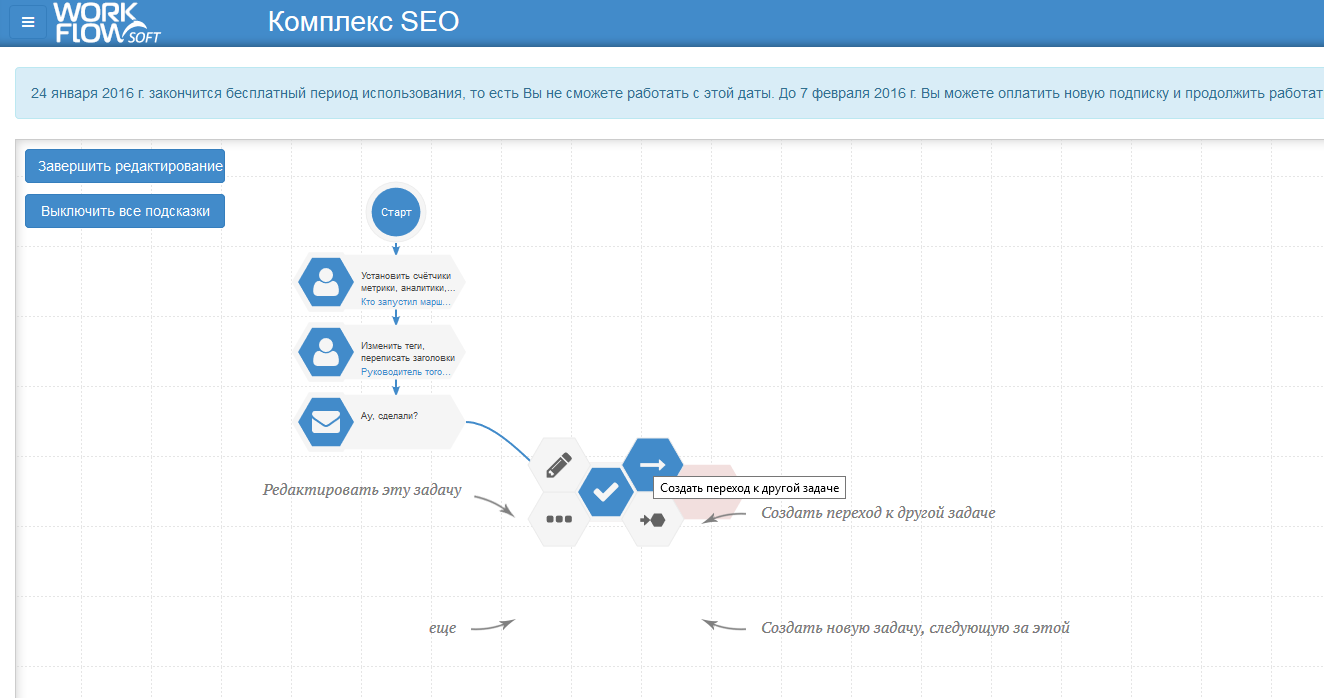
Anyone interested in simple setup of simple business processes without using BPMN notation - take a look.
Asana is one of the most popular project and task management systems. This is no coincidence: she won her popularity with a simple start, transparent logic of work, a convenient interface and a good manual. Of the possible shortcomings is English localization, but I think that learning a couple dozen words of the interface is not a problem for anyone today.
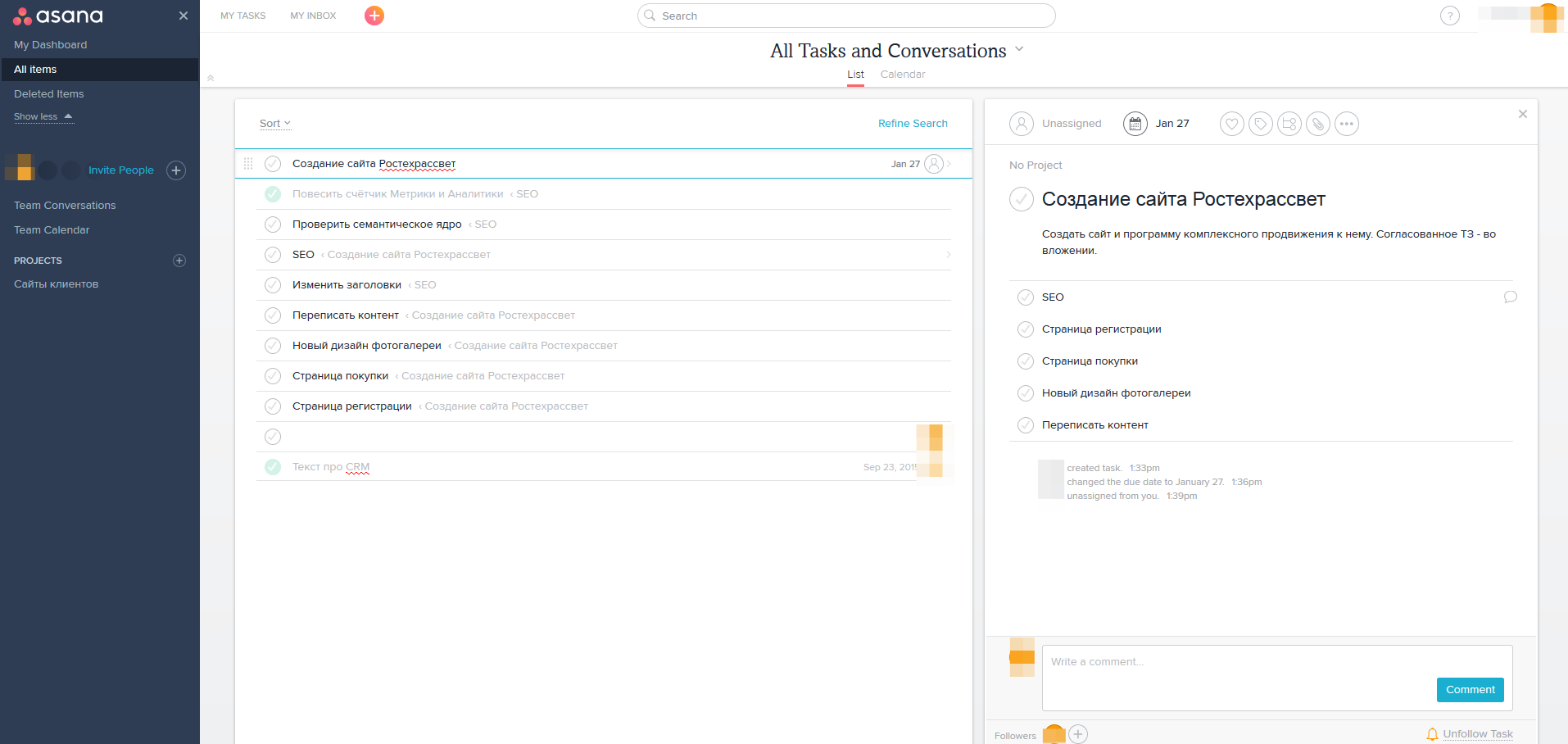
Inside the project (you can create several projects with different groups of employees), a task is created with a description, comment and subtasks in the form of a check list. It is allowed to create subtasks for subtasks of any nesting depth. When creating a task, performers and followers are appointed who will be notified of the progress of work. To complete the task, just check the box - while the closed ones will go to the "All items" section and will not be displayed in the task. Inside Asana, you can also create a group calendar and team chat to discuss tasks. In the event that among the many tasks you need to find something, you can search by a separate field or by the occurrence of a word. Asana allows you to create several work sections that can be used for different projects as well as for different teams (freelancers, remote workers, customers, etc.). In addition, one task can be tied to several projects. Separately, I liked the ability to control hot keys - this greatly speeds up the work. Of the subjective shortcomings is the inability to view all tasks and subtasks in one tree. And unicorns live there too.
Wrike is as popular a system as Asana, but with more features. In Wrike, you can create user groups in the Administration section - again, it’s convenient for managing several projects of different subjects and groups of freelancers. Projects are already being created within the group, and tasks within the projects. By the way, in addition to projects, you can create private and shared folders with tasks. Tasks include subtasks organized as a checklist. Again, several levels of nesting are possible. Unlike Asana, you can configure the display of the entire task tree and enable / disable tasks with the status of "Solved" and "Closed". For each task, a responsible person and followers are set, a start date and dependencies are set; You can attach files and create comments.
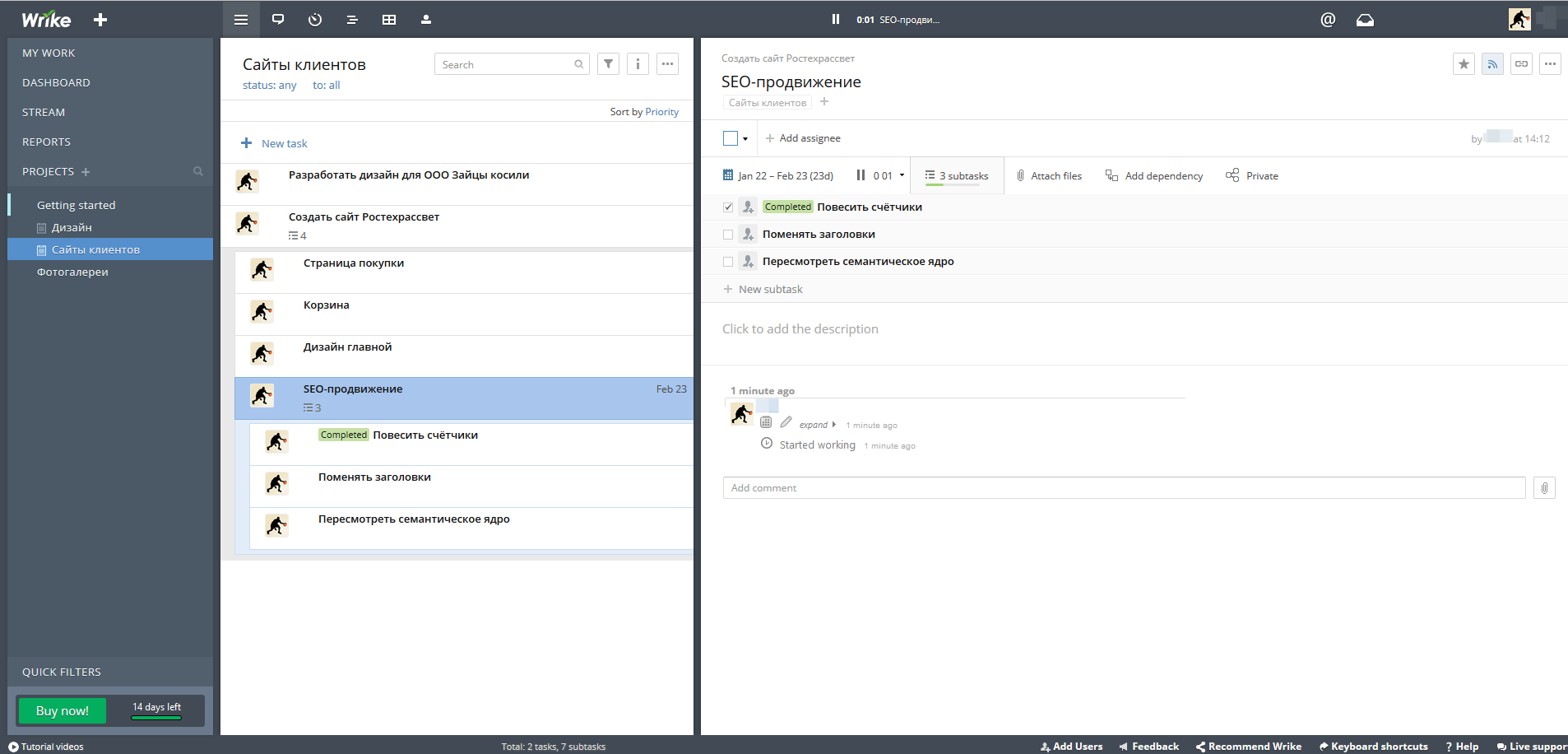
Tasks in Wrike can be viewed in the form of a table (very convenient) and on the Gantt chart. This is perhaps one of the best diagrams that I have encountered during testing of the listed programs: right on the diagram you can drag and drop segments of tasks, change the deadlines for completing tasks and the project as a whole, and establish and break connections between tasks. Plus, the chart is easily scaled using a special slider. Also, the user can customize reports and dashboards for a single project or for all projects of the team.
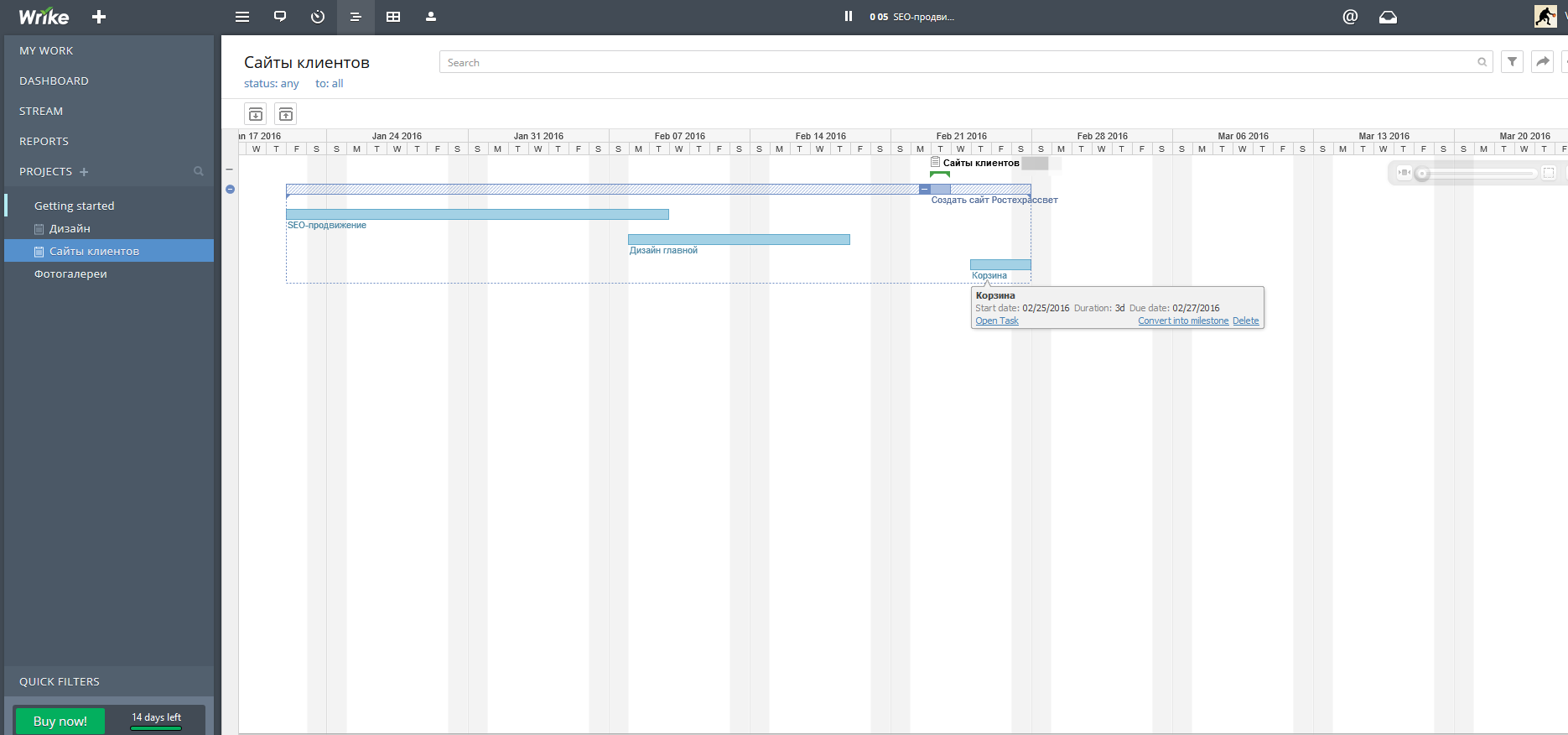
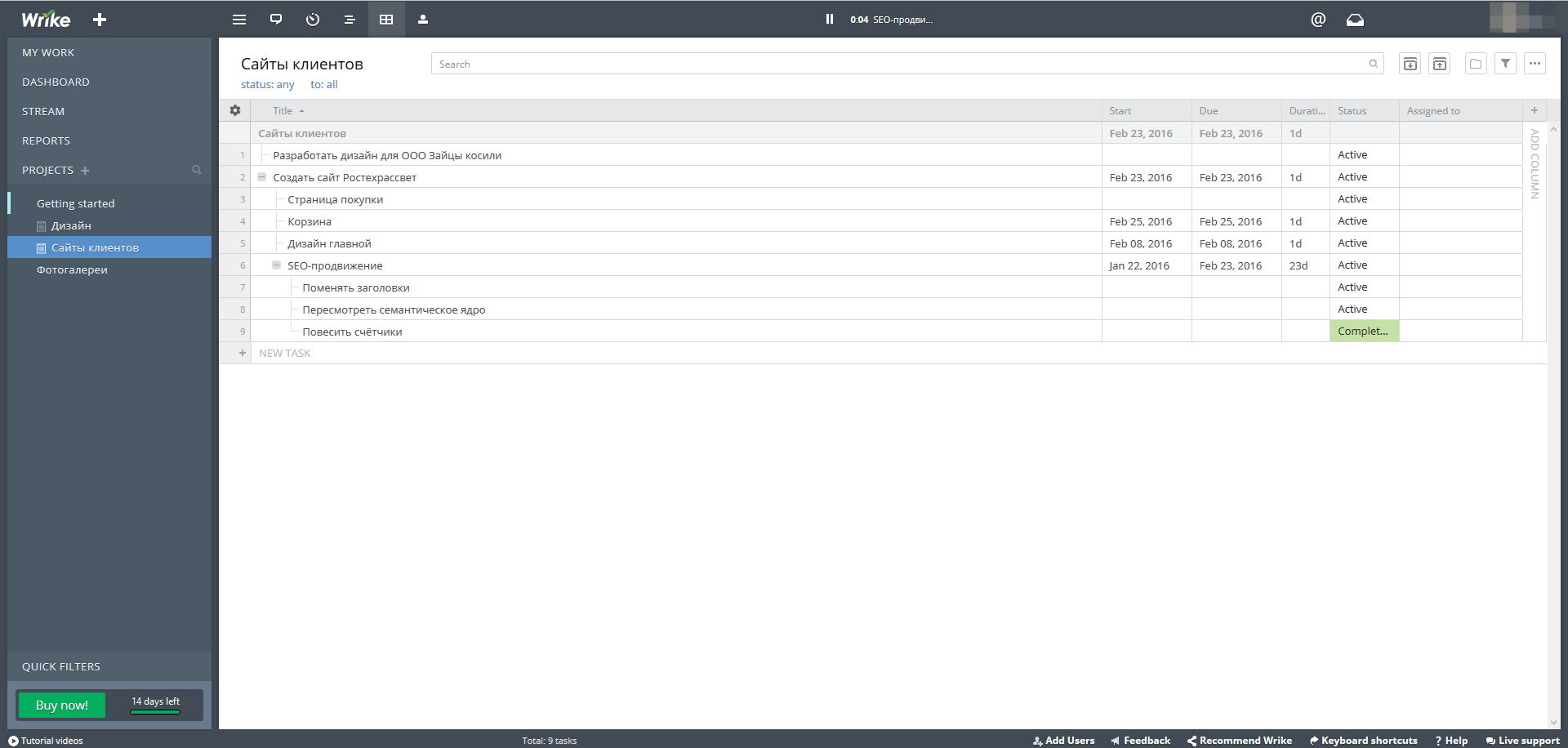
Basecamp - if I was asked to characterize this system, I would call it the most visual and informal. All thanks to the desktop with fixed panels for chat, notes, cases, polls and so on. Basecamp goes a little beyond the scope of a simple task manager, it is also a corporate portal, inside which you can formally and informally communicate with a team or teams that can be created separately. Tasks in Basecamp are a simple to-do list consisting of tasks and many sub-tasks in which the user can set deadlines, artists and followers. The charm of this system is its simplicity and complexity: in one window you can remind about events, chat, remind about open and closed tasks, add documents and files, view reports and logs of the actions of the whole team.

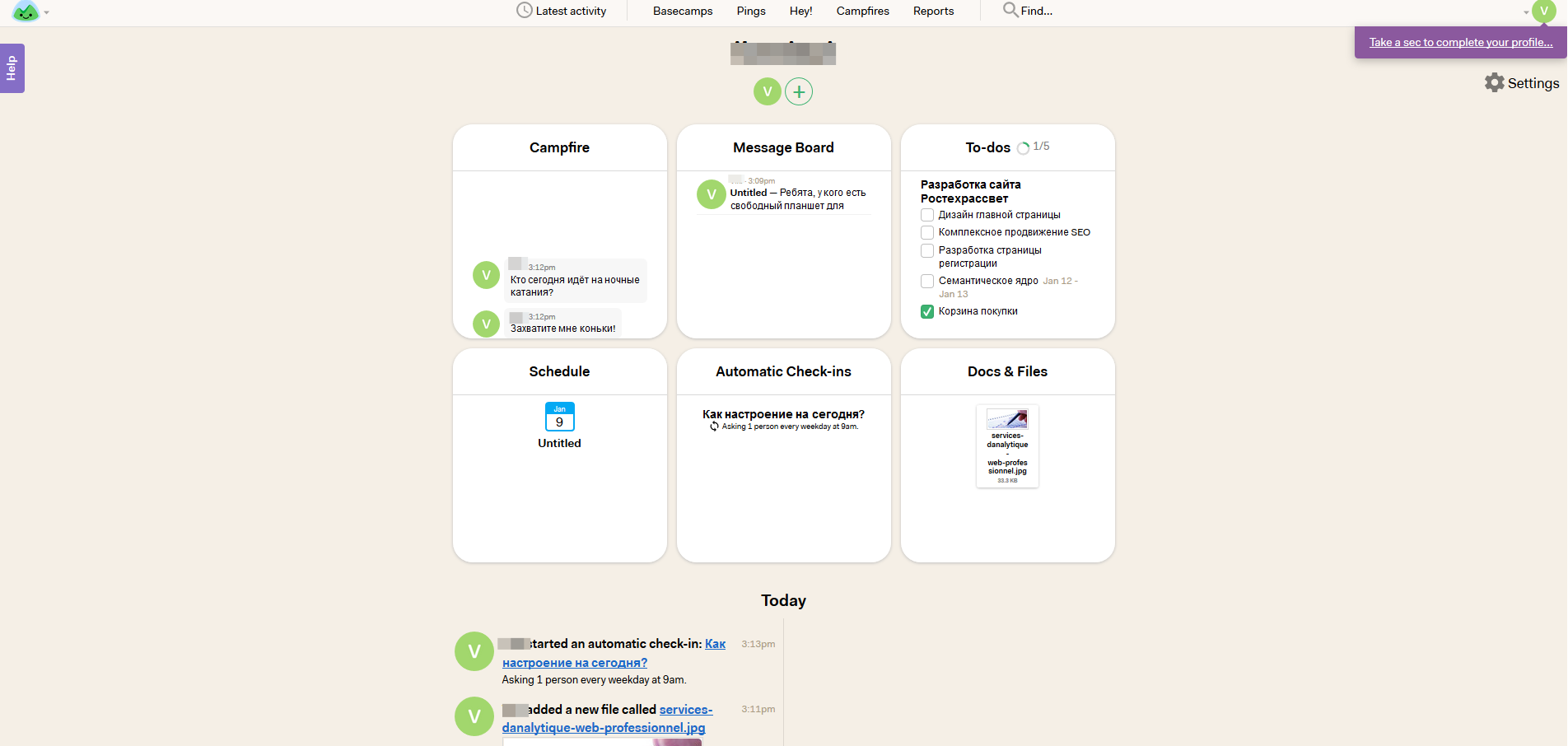
In my opinion, Basecamp is a story for a small team, which is important to keep order in work, but at the same time maintain a relaxed atmosphere.
PTYSH is the very system that we created, having studied many project and task management systems, some of which I told you in a post. It takes into account those needs that I spoke about at the beginning and removed all unnecessary things. PTYSH has already survived several releases and is constantly improving. In PTYSH
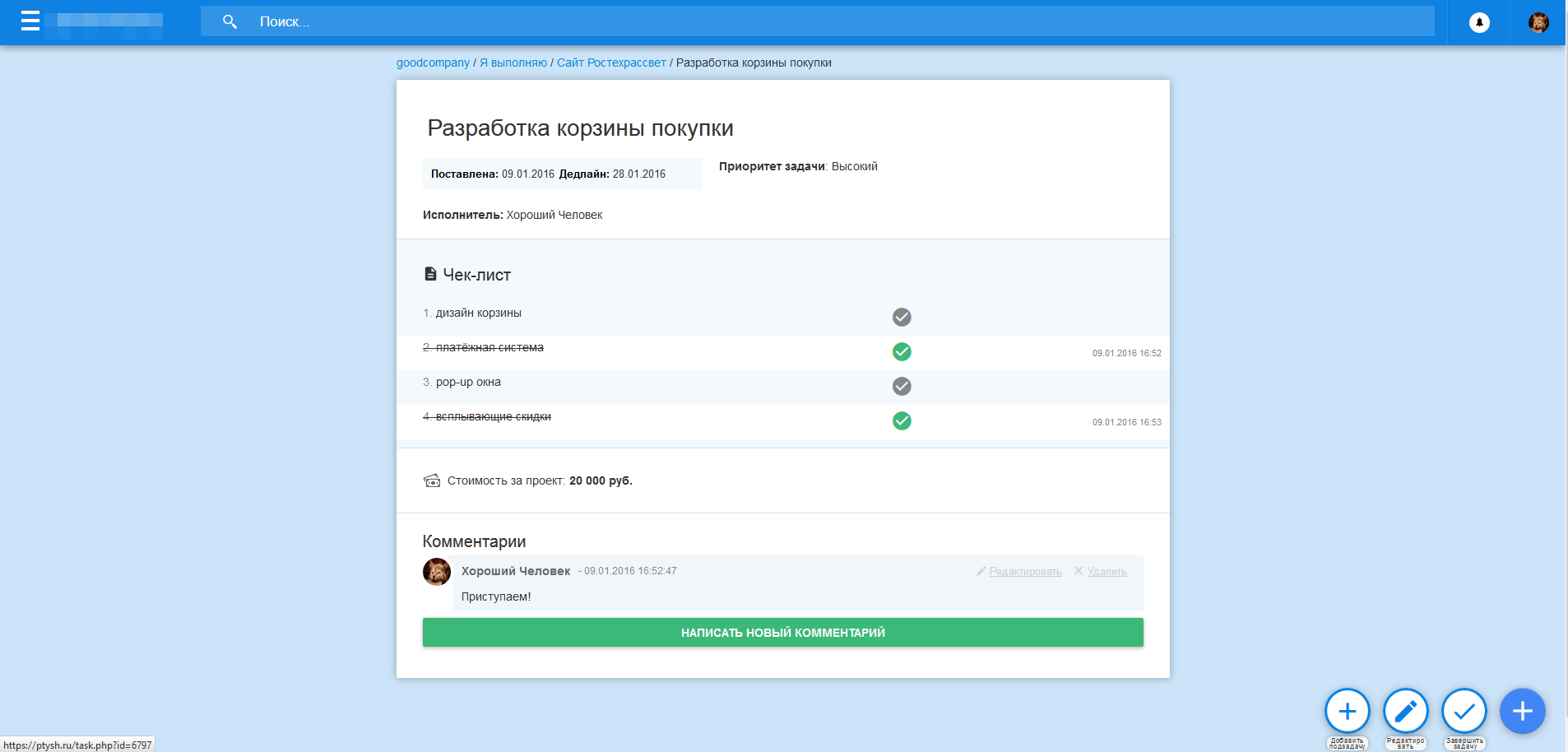
the task is created inside the project. The task form takes into account the specifics of the work of web-studios and, in addition to the fields of name, deadline, artist, project cost and followers, includes several task scenarios: no script, checklist, copywriting, SEO-promotion, website development. Scenarios are constantly updated - so, the script "Contextual Advertising" has already been added. Depending on the selected scenario, additional fields are generated that are specific to the type of work on the task. We have already written in detail about the fields of each scenario in our blog on Megamind. Speaking of checklist. In PTYSH we tried to make it what we dreamed of: the user simply enters all the necessary items through Enter in one field, and when creating a task, a checklist is generated automatically. When completing the subtask, just check the box and crossed out items will appear in your checklist indicating the exact time and date of closing, as well as indicating the employee who has closed, if several responsible people work on the checklist. Bonus for customers is built into any version.PTYSH (including free) checklist for integrated SEO. It is loaded in the case of choosing the scenario "SEO promotion" and contains 70 items, divided into several blocks of work. We also wrote about them.
It is difficult to give universal advice on which system to choose: each company has its own characteristics that determine the needs. I hope that the review will help you initially screen out some decisions and spend less labor on testing systems. Choose, implement, use every day, meet deadlines - the pleasure of work is guaranteed.

Believe me, sometimes the nuances are very important
Well, to make it even easier for you to choose, here is a tablet with the prices of the listed solutions. At the time of compiling the table (and this was January 13, 2016), the dollar exchange rate was $ 1 = 75.97 p. By the way, do not forget about the fluctuation of the exchange rate, acquiring a system whose price is tied to a currency - this can lead to pleasant as well as unpleasant (to them more often) surprises. It happens that the company fixes the course, but this is casuistry.
Note: some companies set discounts when buying for a year, up to 10%. Since the conditions for obtaining discounts are constantly changing, they are not taken into account in the table.
If you find inaccuracies in the description or prices, write in a personal and comments - fix it.
ps For those who do not have time to read. The following systems coped with the tasks best:
PTYSH
Basecamp
Wrike
Asana

 Before diving into Longrid about systems, we briefly define what needs we considered. What is a web-studio? This is a company within which very fast work is going on simultaneously on several projects, each of which may be at a different stage. Thus, employees are forced to strictly prioritize tasks and remember the most insignificant details that cannot be taken into account when creating and managing sites.
Before diving into Longrid about systems, we briefly define what needs we considered. What is a web-studio? This is a company within which very fast work is going on simultaneously on several projects, each of which may be at a different stage. Thus, employees are forced to strictly prioritize tasks and remember the most insignificant details that cannot be taken into account when creating and managing sites. Based on this, we will look for:
- nested hierarchies project-task-subtask
- convenient forms of task creation
- checklists with the ability to display closed subtasks
- quick access to task fields for changing parameters
- quick system deployment
- the ability to assign and change artists and followers
- the ability to create separate groups for freelancers
- the ability to create additional custom fields and change the name of entities.
Of course, the environment of the task manager will also not be deprived of attention, but the emphasis will be placed on the listed parameters. And yes, all screenshots are clickable - you can take a closer look at them.
For those who like hotter
This section includes systems that are customarily used, for example, as a bug tracker or an incident and ticket management system, but which also deserve attention as task managers. I will make a reservation right away - most of them are too complicated and cumbersome for the business processes of the web-studio, but still are of interest.
Trackstudio
Perhaps this is the most unusual system of all that I had to study. The magic of IT retro begins with the installation process itself, when you have to deploy the server manager on the desktop, manually create a clean database and then go to the web-based interface of the system, simultaneously looking at the state of the database. The interface that came to us from the mid-2000s is just as unusual. However, this does not deprive TrackStudiogood project management capabilities. If someone decides to understand, I strongly recommend arming with documentation: there is a lot of useful information for both users and developers. Personally, I was reassured by the title of the section “How to Control the World Using TrackStudio”. Actually, that's what I did. I must say right away that TrackStudio is not a story for web-studios at all, because it is simply not necessary for people like us. Such functionality and powerful refinement tools are more suitable for large companies that squeeze money for expensive systems or for development companies: in my opinion, TrackStudio can be sharpened both under the development management system, and under the bug tracker, and under the ticket and incident management system. Despite this statement, I will dwell on project management in more detail.


Tasks are collected on the desktop of the system and at the same time have a representation in the form of a tree. The main essence is a project in which you can create other projects and tasks. Using TrackStudio, you can create various categories of tasks (bugs, requirements, information, etc.), they will be displayed in conjunction with the project. A task category requires you to configure relationships between categories (where a task can be created) and allows you to configure triggers (then a user-created script can be executed when creating and editing tasks). For all projects, you can build reports in the form of a list, details, distribution report, time spent, task structure, trend, time sheet and Gantt chart. Some reports are downloaded in XML and in the MS Project format; this may be necessary for someone to upload to external systems.

TrackStudio is a powerful and interesting solution for those who have programming skills and time for a long start. I am convinced that with a long setup and preparation, the system can take on any guise and reliably solve various problems, especially since it can be configured for any DBMS. However, for a modest (and not modest too) web-studio, the solution is too complicated, moreover, TrackStudio does not have a ready-made convenient mechanism for completing tasks, checklists, quick task management models (assignment, delegation, control, etc.).
Redmine
On the net you can read thousands of laudatory reviews on Redmine . Moreover, they praise him both as a bug tracker and as a task manager, which means that we have no right to pass by. Frankly, I did not often have to work with the command line in Windows, but Redmine decided to
There I found the most accurate name of what I devoted part of the night to.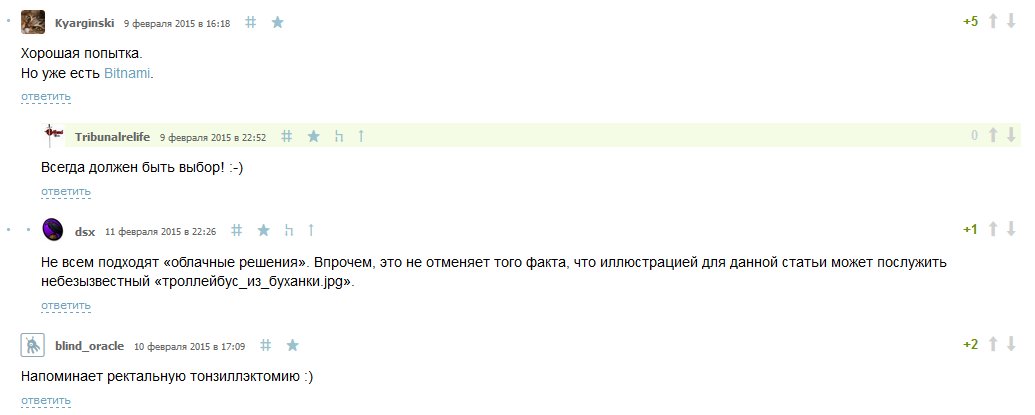

Bitnami deploys Redmine in minutes. So, if you are not a fan of the above operations, run Redmine in the browser and use it as a task management system. Redmine is very simple: minimalistic design, simple menu and a good set of clear settings. Before you start working in the task manager, you should go to the settings in the "Administration" section: there you can create custom sets of trackers, task categories, specify the sets of columns that will be displayed in the task lists. Such preparatory work will allow you to manage tasks initially in an orderly manner.


Tasks in the project are created simply: name, description field, degree of readiness, labor, deadline, status. You can only change the execution status (including close) by editing the task. Checklists are not provided. All tasks are displayed in a calendar and on a Gantt chart: when you hover over a section of a task, you can see its card, dragging and dropping elements with the mouse is not provided. In a separate window you can see the project documents, conduct a discussion on the forum, create and fill in useful information Wiki. In my opinion, Redmine is good precisely because of its many settings (and of course, free of charge). He is good both as a bug tracker and as a task manager, especially for companies in which tasks do not require detailed fragmentation, but are actively discussed and it is important to maintain the accumulated experience of the discussion.

Jira
Since we are talking about Redmine, we will focus on Jira - another system that is popular with developers. When launched, Jira prompts the user to select the necessary modules: developers - Scrum, Kanban, Basic software development; business - process management, project management, task management. The system interface is in English, in the basic delivery you can choose the Russian language of the institution of tasks. However, there is a Russian-language localization, it can be added to the system plug-ins and used by Jira in their native language. By the way, since we are talking about plugins, Jira offers many useful add-ons, among which there is something to choose.

So, when creating Jira, we chose Project management, which means that the main essence of this section is the project. Tasks are registered inside the project using the form in which the fields for the deadline date, responsible, attachments, formatted description, followers, priority, tags and comments are defined. If necessary, unnecessary fields can be eliminated by saving the user set of fields of the institution. Inside the task, subtasks are created in the form of a list in which the status of execution is displayed. All tasks and subtasks are displayed in the left pane in a list, next to a description of the selected item. Completed tasks can be displayed in the general list by selecting the appropriate option. Based on the results of the work, you can build reports based on ready-made templates. Summary of activities and task structure are available in the Summary section.

In general, Jira is quite convenient for working with projects, work with freelancers can be moved to a separate section. If the company is more focused on development, then Jira will be an excellent choice: each unit will work in its own project and at the same time in a single functional system.
Actually, it's time for Jira to finish with perversions and consider systems more suitable for the tasks.
Systems where task manager is a module
These systems, in turn, are divided into two parts: where project management is a module and where project and task management is almost the only goal of the program. Let me explain why it is sometimes advisable to buy CRM / ERP / xRM with a task management module. If the company starts as a small studio, but has plans to expand its service portfolio and omnichannel promotion, then it is worthwhile to look closely at complex solutions so that it is painfully not to integrate all the software necessary for work. Believe me, there is nothing wrong if your sales people initially start to lead customers to CRM - you will benefit from this by gaining a managed customer base. On the other hand, if you decide to develop in only one direction (for example, to be a web-studio and become the coolest in this direction), then you should limit yourself to a tool, most suitable for the main tasks. So…
amoCRM
amoCRM in the left toolbar offers the tab "Tasks", in which you can directly add tasks and manage them. It is also allowed to assign tasks from the transaction card and contact card. Initially, amoCRM provides two types of tasks: follow-up and meeting. This, of course, is not enough, so literally in a couple of clicks you can create many custom types of tasks: for example, calls, development, design and everything that your activity requires. The form for adding a task is rather meager: choosing the date and exact time, specifying the contact or transaction associated with the task (in fact, you can enter any data in the field), for whom the task (choosing from the list of employees in the system), task type and comment ( surprisingly, it is a required field until you complete it; the task cannot be saved). The ability to create milestones and subtasks was never found,

Tasks in amoCRM can be displayed in the form of a list, a one-day calendar with time divisions, a calendar for a month, as well as a to-do line on which tasks for today and tasks for tomorrow are visible. To close a task from the to-do line, drag it down with the mouse and then another line appears with segments: delete, the day after tomorrow, the next week, the next month, complete. Honestly, a very unobvious interface solution - only an understanding of standard interfaces helped me find it. I think the novice manager would freeze for a long time. In the list view of the task, it’s easier to close the task, for this it is enough to put a hint (tick) at the task name and the menu will open: open tasks, close tasks, delete. When you try to close the task, a window pops up asking you to specify the result. Closed tasks do not appear in the taskbar, but they can be found on the amoCRM desktop in Recent Events and in the corresponding deal. From the pleasant thing - displaying the number of tasks set, completed and expired on the amoCRM desktop dashboard. This dashboard, of course, is not the right thing, but beautiful. Since we are talking about CRM, it is possible to put down the amount of the transaction, track the stages of interaction with customers (funnel).

In general, amoCRM does not quite fit into the needs of web-studio task management. First of all, because this is CRM, aimed primarily at solving the problems of the sales department. The task management module itself does not have the functionality necessary for the studio.
Bitrix24
Tasks actually underlie Bitrix24. When they are created, the name, initiator, co-executors, priority are established, the start and end dates for the task are planned. Inside the task, you can create a checklist with subtasks - this is very convenient for monitoring the stages of the work or the to-do list of the employee. The task can be attributed to the project, which can be created according to the criteria necessary for the user (department, work, direction, office, etc.). For a task, you can choose to followers or employees to whom it is delegated. Homogeneous tasks can be made cyclic or created in the future using saved templates. All tasks are divided by status and can be displayed both in tabular form and on the Gantt chart. In the case of Bitrix24, you can manage tasks directly on the chart rulers: by right-clicking, the task management menu opens, left - the task card opens. By the way, in Bitrix24 it is possible to create work groups for external users.

In terms of working with tasks, Bitrix24 will definitely not fail. However, the system itself is an entire corporate portal with a sales management module and CRM. For web-studio, the system is clearly overloaded. However, these words can be attributed to absolutely all CRM that we studied. In most systems, tasks and schedulers satisfy almost all requirements, but does the company need this? The point here is not even the cost of software, but the fact that each employee will have a lot of unnecessary functionality before their eyes that will only confuse and distract - it's just inconvenient to work. However, as I said, if you need advanced sales and customer management, KPI execution control and accounting, take a look at complex systems.
Megaplan
Megaplan initially positioned itself as a project management system. Gradually, for the sake of the market, he began to disguise himself as CRM, which, however, does not contradict the definition of a customer relationship management system. However, it is the project management and task setting module in Megaplan that has been implemented quite strongly, taking into account the smallest details. The first advantage is the hierarchy and nesting of tasks: tasks, subtasks, milestones, affairs, subprojects are created inside the project. Such a hierarchy allows you to organize work and actually build a project map; access to each element can be obtained by clicking on the link for the name of the task, subtask, etc.

The task creation form provides for a large set of fields, of which the minimum is mandatory. Inside the task, a responsible, possible bonus for execution, deadline, access rights to the fields is set. In the additional fields you can set the duration, start date and finish of the task, set the planned labor costs. Among the participants in the task, you can optionally specify co-contractors, auditors, and customer. If necessary, you can configure the rules for repeating the task every day, week, month or year. Subtasks are created in similar forms. Tasks and subtasks can be completed, edited, removed, deleted, paused, delegated and even fail (in fact, completed without a result and work on the task). Failed and completed tasks are displayed in the list in gray, at the request of the user they can be hidden. In the Megaplan, tasks can be displayed both in the form of a list, hierarchy, and on a Gantt chart. However, the Gantt chart in Megaplan is quite nominal - you can see the tasks on it, but it is impossible to move and edit them directly on the chart.

In general, Megaplan is suitable for almost any company that needs a project management system (except, perhaps, development and industrial companies that make specific requirements for the system). Of the minuses, I note a slightly overloaded interface and a Gantt chart, which, alas, has remained unchanged for three years now. Personally, again, I did not have the classic simple checklist with checkmarks and striking out completed tasks.
For dessert - the most suitable task managers
This included “profile” task managers, each of whom is able to automate and greatly facilitate team work, partially solving the problem of losing critical and missed deadlines. At a certain stage in the development of my company, I would probably choose each of the systems listed in this section.
Pyrus
Next I will review the Pyrus project management system . Pyrus itself positions itself as a system that is different from the project management system, document management and business processes. It is impossible not to note the possibility of integration with many services and the availability of APIs, but we agreed that we are interested in project management, so we turn to it.

The form for creating a task is simple: a large text box for entering the text of the task, linking the task to the project, responsible, deadline, control label, the ability to upload a file (Google Drive, Box, DropBox, OneDrive). Optionally, directly from the card, you can add the task to Google Calendar, assign several stages of coordination and determine the folder for the task. If not a single project was started before the task was created, the project can be created directly from the task card in a separate window - conveniently. You can also create custom templates for creating a business process (for example, routing and approval of documents), specify the budget of each stage. It is possible to create repetitive tasks, this is the necessary functionality for routine tasks, which there are always a lot of in web studios. All tasks are divided into folders: incoming, last, on the control. Inbox in turn, laid out in "long boxes": today, planned, next, someday. I do not know about you, but such a classification seemed mysterious and not clear enough to me.
Tasks can be reassigned, linked to another project and completed with different results. Like in several other systems, I didn’t have enough checklist, fields for adding brief notes for each participant in the process and didn’t like that tasks after completion are forcibly put into “All tasks” and are not displayed in other folders. In general, the system does not quite fit the tasks, although I am sure that those who need them will forgive everything for its integration capabilities.
iQ300
iQ300- An affordable, understandable project management system that meets almost all the requirements that a small company can make to such systems. A cloud system with a concise interface and obvious entities makes it possible to create projects, tasks, checklists (finally!), Write comments, attach documents and log all user actions. The main essence is the project, within which tasks and subtasks are created. When creating a project, a fairly complete card is formed, taking into account goals, risks, success criteria, and result. Of the obviously pleasant things, it’s possible to create working groups (communities): for example, you can create Freelancers, Udalenka, and Branch in Cheboksary groups and separately monitor activity, speed of work with tasks, and overall progress. This is the functionality

However, not everything is so simple - the first pleasant impression is erased somewhat in the process of creating tasks. Judge for yourself: initially a draft of the task and subtasks is created, then you must manually change the status of the task to "In Work". By the way, this can be done through the "Convert to task" menu: here you are involuntarily wondering what will happen if you use such a conversion for a subtask? Spoiler: nothing will happen, the subtask will become active. When creating a task, the field of the person responsible for the execution is not mandatory, however, if you want to activate the task and the executor is not there, you will not succeed and no hints will pop up - guess yourself as you work. However, after several clashes with restrictions, you begin to understand the logic of the system and it becomes quite friendly: check lists are easy to close, you can enable or disable the display of various types of tasks, including completed ones, control is carried out through a simple menu, group operations are possible. Within the project, you can discuss, there is a schedule (in essence - a basic Gantt chart with the ability to view the task when you hover over a segment and drag the rulers and time axes), in a separate tab there are documents and multimedia about the project, you can build reports on tasks, performers, the course of execution of orders, the time spent. Tasks, depending on the status, are highlighted in different colors - everything is very clear. there is a schedule (in essence - a basic Gantt chart with the ability to view the task when you hover over a segment and drag the rulers and time axes), in a separate tab there are documents and multimedia for the project, you can build reports on tasks, executors, and the execution of instructions, time spent. Tasks, depending on the status, are highlighted in different colors - everything is very clear. there is a schedule (in essence - a basic Gantt chart with the ability to view the task when you hover over a segment and drag the rulers and time axes), in a separate tab there are documents and multimedia for the project, you can build reports on tasks, executors, and the execution of instructions, time spent. Tasks, depending on the status, are highlighted in different colors - everything is very clear.

The system is extremely easy to learn, but despite this, it provides manual lessons with screenshots and good recommendations for managing tasks and projects. Of the shortcomings, I will highlight the sometimes illogical behavior of the interface and the inability to display checklists in the project field, access to them is possible only through the task. Using the iQ300 is a matter of habit, it took me less than an hour to form.
Workflow soft
WorkFlow Soft is another system that I came across in the course of my global research. In principle, it is no different from many reminder systems: there are no check lists, task category labels, etc., tasks are created in the minimum standard form. But the system cannot exist without chips: in WorkFlow Soft it is a constructor of templates and task execution routes. Routes are constructed in an interface that is clear and pleasant to the eye, attached to the task and can be launched for execution - in fact, this is one of the options for modeling business processes. Obviously, the stake is made precisely on the logical coherence of tasks and the possibility of building chains of work: from coordinating a document to developing a site and releasing a new product.


Anyone interested in simple setup of simple business processes without using BPMN notation - take a look.
My cherries on the cake
Asana
Asana is one of the most popular project and task management systems. This is no coincidence: she won her popularity with a simple start, transparent logic of work, a convenient interface and a good manual. Of the possible shortcomings is English localization, but I think that learning a couple dozen words of the interface is not a problem for anyone today.

Inside the project (you can create several projects with different groups of employees), a task is created with a description, comment and subtasks in the form of a check list. It is allowed to create subtasks for subtasks of any nesting depth. When creating a task, performers and followers are appointed who will be notified of the progress of work. To complete the task, just check the box - while the closed ones will go to the "All items" section and will not be displayed in the task. Inside Asana, you can also create a group calendar and team chat to discuss tasks. In the event that among the many tasks you need to find something, you can search by a separate field or by the occurrence of a word. Asana allows you to create several work sections that can be used for different projects as well as for different teams (freelancers, remote workers, customers, etc.). In addition, one task can be tied to several projects. Separately, I liked the ability to control hot keys - this greatly speeds up the work. Of the subjective shortcomings is the inability to view all tasks and subtasks in one tree. And unicorns live there too.
Wrike
Wrike is as popular a system as Asana, but with more features. In Wrike, you can create user groups in the Administration section - again, it’s convenient for managing several projects of different subjects and groups of freelancers. Projects are already being created within the group, and tasks within the projects. By the way, in addition to projects, you can create private and shared folders with tasks. Tasks include subtasks organized as a checklist. Again, several levels of nesting are possible. Unlike Asana, you can configure the display of the entire task tree and enable / disable tasks with the status of "Solved" and "Closed". For each task, a responsible person and followers are set, a start date and dependencies are set; You can attach files and create comments.

Tasks in Wrike can be viewed in the form of a table (very convenient) and on the Gantt chart. This is perhaps one of the best diagrams that I have encountered during testing of the listed programs: right on the diagram you can drag and drop segments of tasks, change the deadlines for completing tasks and the project as a whole, and establish and break connections between tasks. Plus, the chart is easily scaled using a special slider. Also, the user can customize reports and dashboards for a single project or for all projects of the team.


Basecamp
Basecamp - if I was asked to characterize this system, I would call it the most visual and informal. All thanks to the desktop with fixed panels for chat, notes, cases, polls and so on. Basecamp goes a little beyond the scope of a simple task manager, it is also a corporate portal, inside which you can formally and informally communicate with a team or teams that can be created separately. Tasks in Basecamp are a simple to-do list consisting of tasks and many sub-tasks in which the user can set deadlines, artists and followers. The charm of this system is its simplicity and complexity: in one window you can remind about events, chat, remind about open and closed tasks, add documents and files, view reports and logs of the actions of the whole team.


In my opinion, Basecamp is a story for a small team, which is important to keep order in work, but at the same time maintain a relaxed atmosphere.
PTYSH
PTYSH is the very system that we created, having studied many project and task management systems, some of which I told you in a post. It takes into account those needs that I spoke about at the beginning and removed all unnecessary things. PTYSH has already survived several releases and is constantly improving. In PTYSH

the task is created inside the project. The task form takes into account the specifics of the work of web-studios and, in addition to the fields of name, deadline, artist, project cost and followers, includes several task scenarios: no script, checklist, copywriting, SEO-promotion, website development. Scenarios are constantly updated - so, the script "Contextual Advertising" has already been added. Depending on the selected scenario, additional fields are generated that are specific to the type of work on the task. We have already written in detail about the fields of each scenario in our blog on Megamind. Speaking of checklist. In PTYSH we tried to make it what we dreamed of: the user simply enters all the necessary items through Enter in one field, and when creating a task, a checklist is generated automatically. When completing the subtask, just check the box and crossed out items will appear in your checklist indicating the exact time and date of closing, as well as indicating the employee who has closed, if several responsible people work on the checklist. Bonus for customers is built into any version.PTYSH (including free) checklist for integrated SEO. It is loaded in the case of choosing the scenario "SEO promotion" and contains 70 items, divided into several blocks of work. We also wrote about them.
It is difficult to give universal advice on which system to choose: each company has its own characteristics that determine the needs. I hope that the review will help you initially screen out some decisions and spend less labor on testing systems. Choose, implement, use every day, meet deadlines - the pleasure of work is guaranteed.

Believe me, sometimes the nuances are very important
Well, to make it even easier for you to choose, here is a tablet with the prices of the listed solutions. At the time of compiling the table (and this was January 13, 2016), the dollar exchange rate was $ 1 = 75.97 p. By the way, do not forget about the fluctuation of the exchange rate, acquiring a system whose price is tied to a currency - this can lead to pleasant as well as unpleasant (to them more often) surprises. It happens that the company fixes the course, but this is casuistry.
| System | Price declared on the site | Cost of ownership for 1 year per team of 10 people | Note |
|---|---|---|---|
| Bitrix24 | 12 uses - 0 p. Project - 990 rubles / month., 24 users. Team - 4 990 rubles / month. | 12 uses - 0 p. 24 uses - 11 880 p. Team - 59,880 p. | The “Team” tariff is necessary to use the extranet for external users of the system (clients, freelancers) |
| amoCRM | Базовый — 499 р./мес./польз. Расширенный — 799 р./мес./польз. | 95 880 р. | Создание задач возможно, начиная с пакета «Расширенный», выбираем его. |
| Мегаплан | Совместная работа: облако — от 290 р./мес./польз. сервер на 10 польз. — 47 400 единовременно | 34 800 р. | В тариф входят задачи, общение, документы, без финансов. По моде, берём облако. |
| Pyrus | Бизнес: 9 р./польз./день | 32 850 р. | Старшие тарифы предполагают расширенные интеграционные возможности |
| PTYSH | до 3-х чел. — 0 р. остальные — 990р./мес. без ограничений за всё | 11 880 р. | Нет стоимости за пользователя |
| IQ 300 | Старт (2 проекта, 5 польз.) — 0 р. Стартап (10 проектов, 20 польз.) — 1 500 р./мес. | 18 000 р. | Тарифы имеют дополнительные ограничения |
| WorkFlow Soft | Облако и сервер: 15 польз. — 48 000 р./год 25 польз. — 60 000 р./год | 48 000 р. | В старших версиях серверная версия дороже облачной версии |
| Basecamp | 29 $/мес. без огр.польз. 79 $/мес. с ведением клиентов 3000 $/год — Enterprise | 26 438 р. | Ведение клиентов — набор функций для совместной работы с клиентами. Берём минимум. |
| Asana | до 15 польз. — 0 р. 8,33 $ в мес. и меньше | 0 р., 75 939р. бизнес | Прогрессивные скидки |
| Wrike | до 5 польз. — 0 р. 5 польз. — 49 $/мес.* 15 польз. — 99 $/мес. | 90 252 р. | *на тарифе недоступны подзадачи, дашборды и групповая обработка задач. По нашим условиям выбираем с подзадачами. |
| Track Studio | 5 польз. — 0 р. 10 польз. — 13 950р. | 13 950р. | Several tariffs depending on server capabilities and access to the repository with the system sources on GitHub |
| Jira Core ** | Cloud: 10 users - 10 $ / month 15 uses - 50 $ / month 25 uses - $ 100 / month. | 9 116 RUR | ** version for project management. The server is expensive, only for 10 users. - 10 $ |
| Redmine | is free | is free | Distributed under the GNU GPL v.2 license |
Note: some companies set discounts when buying for a year, up to 10%. Since the conditions for obtaining discounts are constantly changing, they are not taken into account in the table.
If you find inaccuracies in the description or prices, write in a personal and comments - fix it.
ps For those who do not have time to read. The following systems coped with the tasks best:
PTYSH
Basecamp
Wrike
Asana
